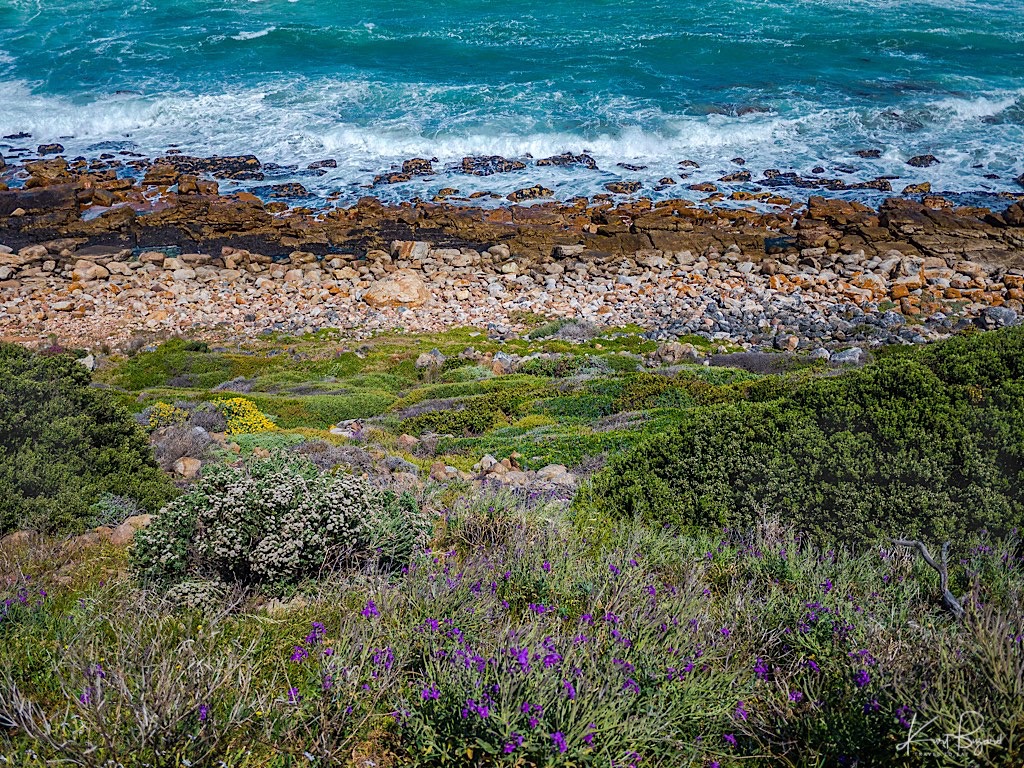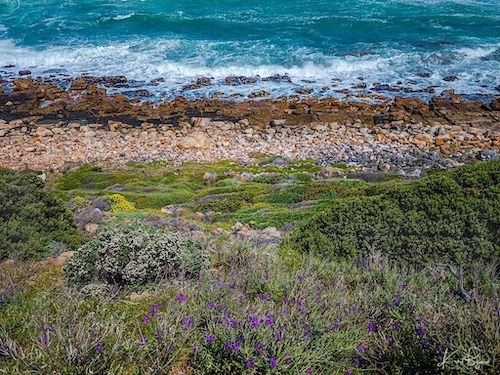
Cape Point is in the Cape of Good Hope Nature Reserve within Table Mountain National Park, which forms part of the Cape Floral Region, a World Heritage Site. It includes the majestic Table Mountain chain, which stretches from Signal Hill to Cape Point, and the coastlines of the Cape Peninsula. This narrow stretch of land, dotted with beautiful valleys, bays and beaches, contains a mix of extraordinarily diverse and unique fauna and flora. The Cape Peninsula (around 470 sq km) has 2285 flowering plant species. Table Mountain National Park alone has 1470 of these. Mountain fynbos dominates the park. It’s characterised by four main groups: protea shrubs with large leaves (proteoids), fine-leaved shrubs (ericoids), wiry, reed-like plants (restioids) and bulbous herbs (geophytes). Table Mountain National Park includes the Cape of Good Hope and Cape Point. Although the Cape of Good Hope Nature Reserve (or Cape Point as it is colloquially called) occupies only 16% of the area of the Cape Peninsula as given by Adamson & Salter (1950), the flora of Cape Point comprises 41% of the flora of the whole Peninsula. This illustrates the fact that many of the habitats and plant communities of the Peninsula are represented at Cape Point. Cape Point is the windiest place in South Africa and experiences only 2% of all hours in the year with calm conditions. I also want to mention that all of the following photographs were taken in October, in the middle of spring in the Southern Hemisphere.
Fynbos
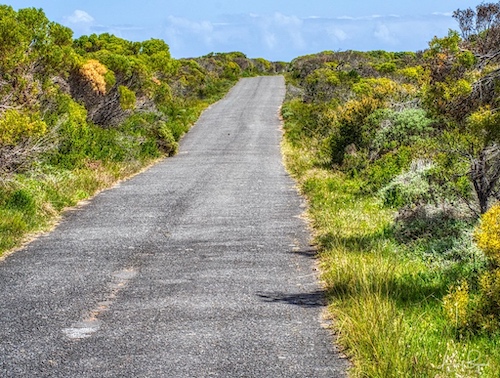
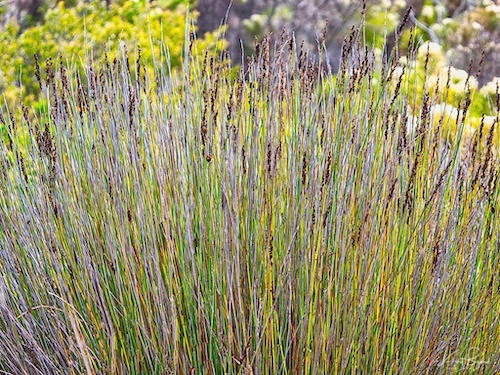
Fynbos appears unimpressive from a distance. It is treeless, scrubby and brown – ‘fine bush’ in the sense of thin, straggly and not very productive. It is a heathland – resembling similar environments in Europe, Australia and South America growing in nutrient-deficient soil under tough climatic conditions. Fine bush indeed, but on closer inspection fynbos reveals itself to be a mesmerising mosaic of plants bursting with flowers every month of the year. Proteas are the most famous plants in fynbos but it’s the restios – the Cape Reeds – that define its presence. Other familiar names found in fynbos are heathers, irises, daisies and orchids as well as members of the citrus, pea and carrot families. Two biological juggernauts collide in fynbos. Firstly, there is a stupendous number of plants species present. Europe, for example, has 20 different types of heather; the fynbos – covering an area the size of Portugal – has 652. And secondly, so many fynbos plants – around 70% – are completely unique to the region. “Every bit of fynbos you can see today has been repeatedly burned to the ground over tens of thousands of years. It covers the mountains because of fire. How so? Go back in time four or five million years and the Cape landscape was covered in thick, dripping forest. Two million years ago the climate dried up and fire was introduced to these hot, windy mountains. In the face of flames, trees retreated to fireproof ravines such as Table Mountain’s Skeleton Gorge. In their place came fynbos plants, many of which had been biding their time since the dinosaurs and were quick to adapt to the new regime: fire, wind, sun, few nutrients and little water.”
Shepherds Tree
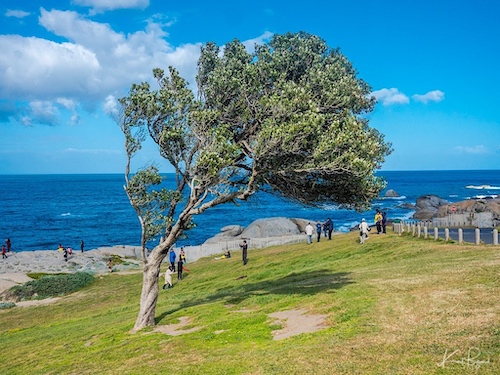
Shepherd’s Tree (Boscia albitrunca) Is a protected tree in South Africa. The species epithet “albitrunca” refers to the oftentimes white trunk. Traditionally, the shepherd tree was used by Dutch settlers, “boers”, to create a variant of coffee that is derived from the roots of the tree. It is an evergreen tree native to southern and tropical Africa, living in the hot, dry, and often brackish low-lying areas, sometimes on abundant lime or occasionally found in rocky terrain. It is a common tree of the Kalahari, bushveld and lowveld. It is one of the most important forage trees in the Kalahari. It is the most common of the eight species in its genus and is usually found in the drier parts of southern Africa. It is often called the Tree of Life as it offers sustenance to both humans and animals. Trees are uncommon on the Cape Peninsula, probably due to the wind and dry conditions. The exception was Hout Bay, Houtbaai in Africaans, meaning “Wood Bay”. Van Riebeeck described the forest of Hout Bay as being the finest in the world. It was Van Riebeeck who gave Hout Bay its present name. In 1652 on 22 November Van Riebeeck wrote in his journal about T’ Houtbaaitjen. Since then it has been known as Hout Bay.
Camphor Tree
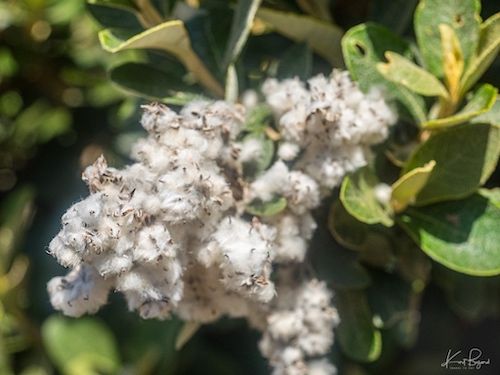
For a small evergreen tree that will thrive in windy, coastal conditions, through drought, and in nutrient-poor, sandy soil, look no further than Tarchonanthus littoralis. You may know it better as the Camphor Tree (Tarchonanthus camphoratus), but a recent study has shown that T. camphoratus was made up of five distinct species that have now been individually named and described. The revised T. camphoratus occurs in the northern part of southern Africa whereas this recently defined species, Tarchonanthus littoralis, occurs along the south and southeastern coast of South Africa. Tarchonanthus littoralis occurs from the Cape Peninsula in the Western Cape, along the coast, on hillsides, dunes and river banks, through the Eastern Cape to KwaZulu-Natal. Tarchonanthus littoralis is dioecious, meaning that the male and female flowers are carried on different trees. Peak flowering time is during mid to late summer (December-March). A month or so after flowering, each female flower has become a cotton-wool-like ball of shiny white fragrant hairs, that fluffs out more as it matures. The small seed is buried inside the puff of white hairs. The brown star in amongst the woolly hairs is the remains of the corolla tube and style. The white fruiting inflorescences are extremely showy against the dark green foliage, and remain decorative for many months. While the female trees are still looking beautiful, the male flowers are dead and brown and the male trees are quite drab in comparison.
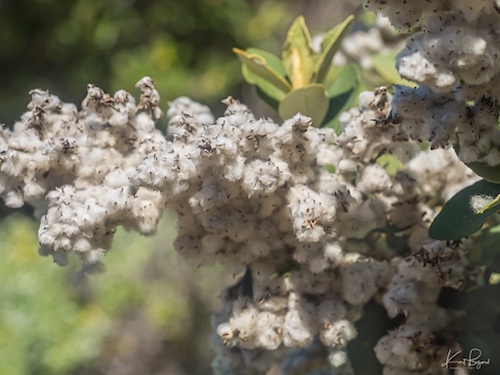
There are two possible explanations for the name Tarchonanthus : one, that it is based on the Arabic name tarchon for tarragon, Artemisia dracunculus, and the Greek, anthos, meaning flower, alluding to the similarity of the flower heads of the two species; the other, that it is from the Greek, tarchos, meaning funeral rites, perhaps due to the camphor scent of the leaves. The species name littoralis is from the Latin litoralis and means of the shore, seashore or coast, alluding to its coastal habitat. Both the leaves and the wood have a strong smell of camphor, hence its common name. Eriocephalus africanus Known as Snow Bush (Kapokbos) Eriocephalus africanus has a similar appearance but is
covered in fluffy white fruiting heads from late spring to early summer.
Dune Conebush
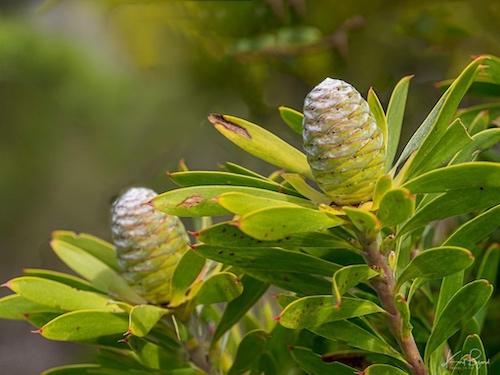
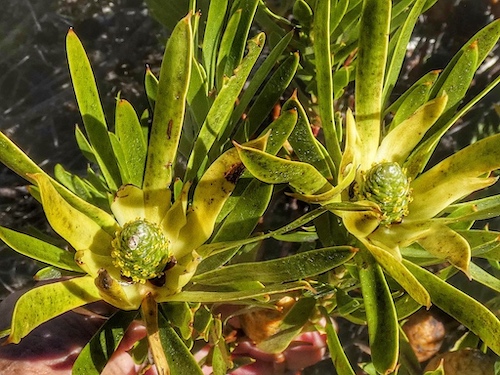
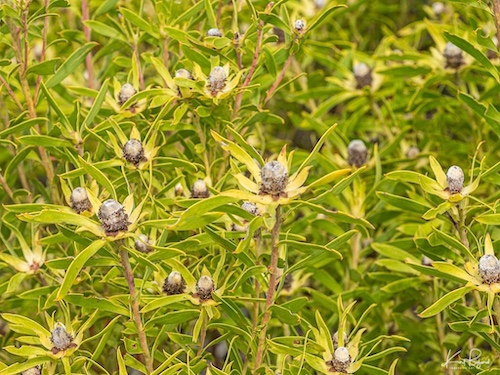
Leucadendron coniferum, also known at the dune conebush, is an evergreen, dioecious shrub or small tree of up to 13 feet (4 m) high, that has been assigned to the family Proteaceae. It has a whorl of conspicuous yellow leaves subtending the flowerheads. The flowers can be found in August and September. I arrived in October and although I looked around, I could not find any flowering, so I have included a photo from Wikipedia. It grows in sandy soils near the coast of the Western Cape province of South Africa.
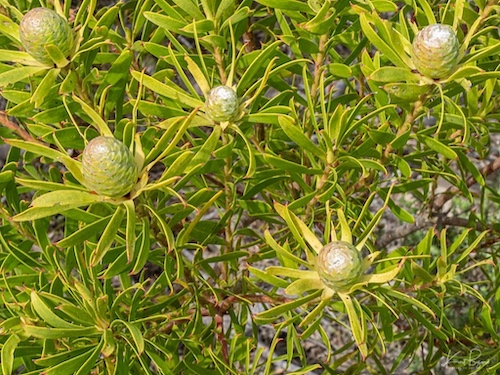
The dune conebush can be found from the Cape Peninsula in the west, through the coastal areas of the Kogelberg, Kleinmond, and Groenland, to the Klein River Mountains in the east near Hermanus, where it grows in dense stands on wind-blown sands, between sea level and about 300 m (900 ft) altitude. It is pollinated by small beetles. The seeds remain up to many years in the woody cones on the female plants, until they are released after a fire. The winged seeds are transported by the wind. Adult plants do not survive the wildfires that occur every decade or so in the sand fynbos and strandveld in which the dune conebush lives. Germination starts quickly after the seed are released and it has been shown that smoke promotes their germination of the seeds.
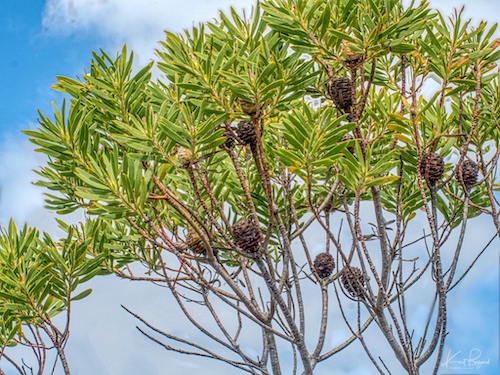
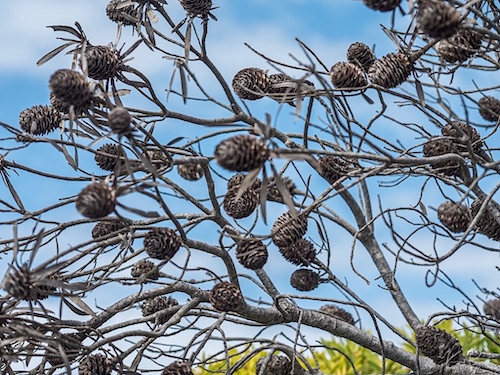
The cones with their papery bracts, that look like spruce cones and are known as “sabulosum cones”, are sometimes gathered and used in potpourri.
Tree Pincushion
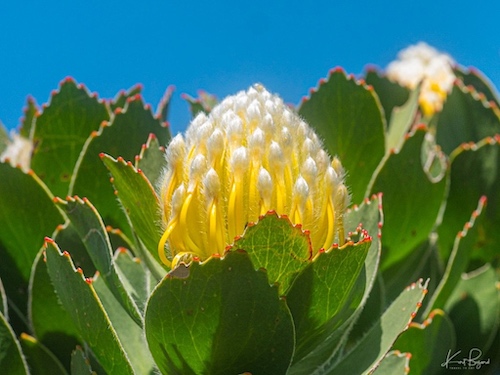
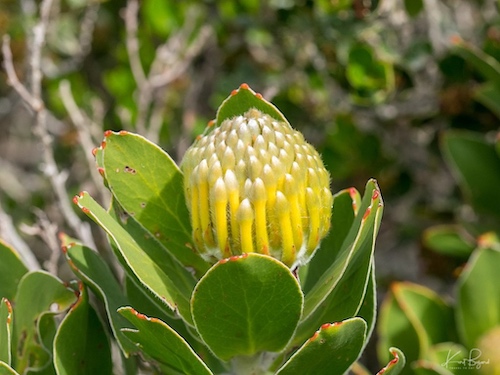
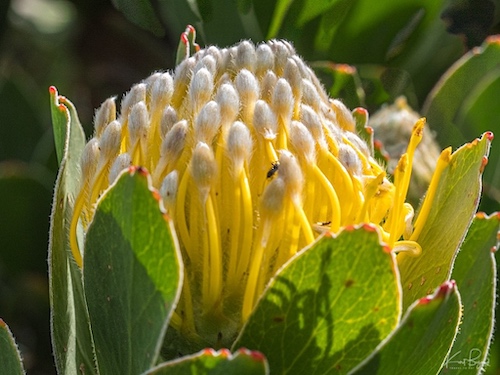
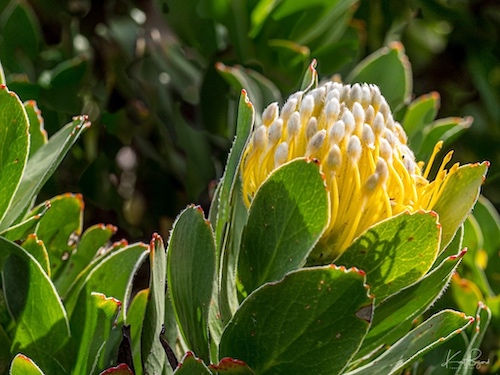
Leucospermum conocarpodendron is the largest of the pincushion group of proteas, Green Tree Pincushion, Hairless Tree Pincushion, Yellow Pincushion (Eng.); Groenkreupelhout, Kreupelboom, Goudboom, Brandhoutboom (Afr.) is absolutely spectacular when in flower. The large rounded bushes are then covered with bright yellow pincushion flowers which glow among the deep green leaves and are further decorated by the antics of the Cape Sugarbirds which feast on the plentiful nectar. Leucospermum conocarpodendron, is the largest species of the genus reaching almost tree-like proportions of 5–6 m (16–20 ft) high, with a firm trunk that is covered in a thick layer of cork that protects it from most fires, with greyish or green narrow or broad inverted egg-shaped leaves with three to ten teeth near the tip, and large yellow flowerheads, with firm, bent, yellow styles that stick far beyond the rest of the flower and give the impression of a pincushion. It is commonly known as the tree pincushion in English or goudsboom in Afrikaans. They occur naturally near Cape Town. Two subspecies are distinguished. L. conocarpodendron subsp. conocarpodendron, has greyish leaves because they have a covering of felty hairs. L. conocarpodendron subsp. viridum, has green leaves that lack felty hairs. Flowers can be found between August and December.
Beesbos
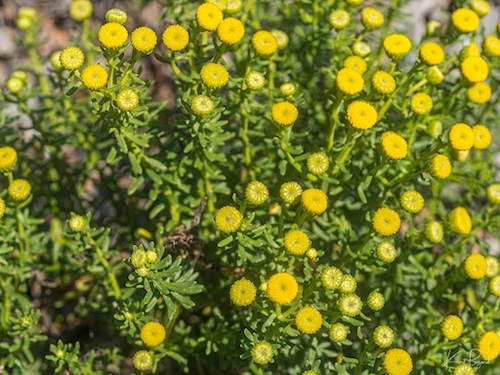
Chrysocoma coma-aurea is endemic to the Western Cape Province, from the Cape Peninsula to Hermanus, and is found on flats and lower slopes. It is now an invasive species in Western Australia. It can tolerate salt winds, and is frost tolerant. This plant thrives in a climate with a dry summer and wet winter season. The yellow, discoid or button-like flower heads, grow singly, on stalks at the stem tips. These flower heads lack the ray florets that are found in conventional daisies. This shrub flowers from October to January. Chrysocoma is derived from the Greek, khrusos = gold, kome = hair, lock, in allusion to the terminal, golden flower heads. Coma-aureus from the Latin, coma meaning a ‘head’ and aureus meaning ‘yellow’. Chrysocoma is a genus of 23 species recorded so far. Whereas Chrysocoma coma-aurea is endemic to the Western Cape, other species occur in other provinces, including the Northern Cape, the Free State, Kwa-Zulu Natal, and North West Province, and neighbouring countries, which include Malawi, Mozambique, Lesotho and Namibia.
Rooibos
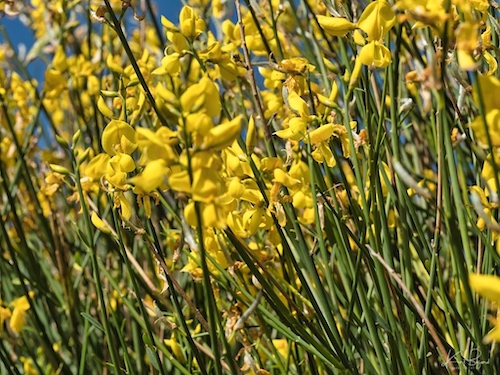
Rooibos, meaning “red bush”, is a broom-like member of the plant family Fabaceae that grows in South Africa’s fynbos. The leaves are used to make a herbal tea that is called by the names: rooibos (especially in Southern Africa), bush tea, red tea, or redbush tea (predominantly in Great Britain). The tea has been popular in Southern Africa for generations, and since the 2000s has gained popularity internationally. The tea has a taste and color somewhat similar to hibiscus tea, with more or less of an earthy flavor like yerba mate. By the late 1920s, growing demand for the tea led to problems with supply of the wild rooibos plants. As a remedy, Dr Pieter Lefras Nortier, district surgeon in Clanwilliam and avid naturalist, proposed to develop a cultivated variety of rooibos to be raised on appropriately situated land. Nortier worked on cultivation of the rooibos species in partnership with farmers Oloff Bergh and William Riordan, and with encouragement from Benjamin Ginsberg. Dr. Nortier’s research was ultimately successful and he subsequently showed all the local farmers how to germinate their own seeds. Dr Nortier is today accepted as the father of the rooibos tea industry.
Snake Thistle
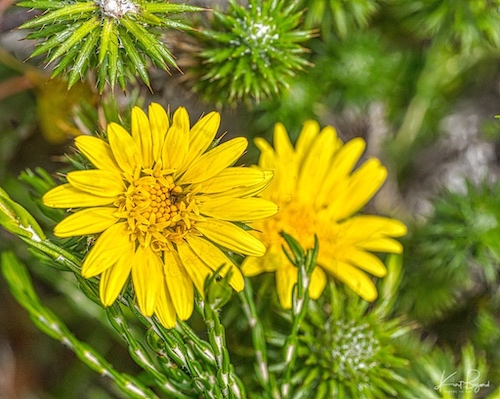
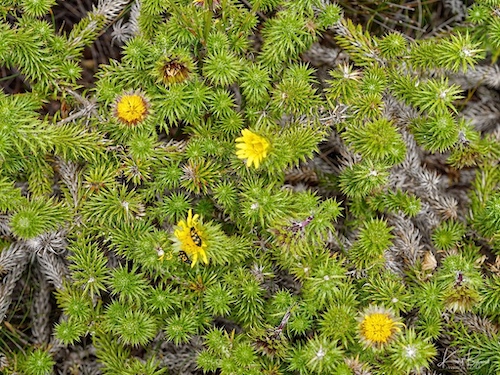
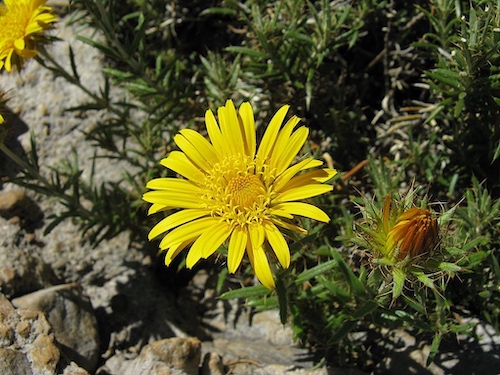
Common names include Snake Thistle, Coastal Bush Thistle, Steekhaarbo. Historical records indicate that this species was formerly very common on sandy coastal lowlands from the Cape Peninsula to the Agulhas Plain, but many of these areas have now been transformed by urban and coastal development, with many subpopulations now lost around Noordhoek, Simon’s Town, Macassar, Pringle Bay and Hermanus. It is however still common in the Cape Point section of the Table Mountain National Park.
Golden Carpet
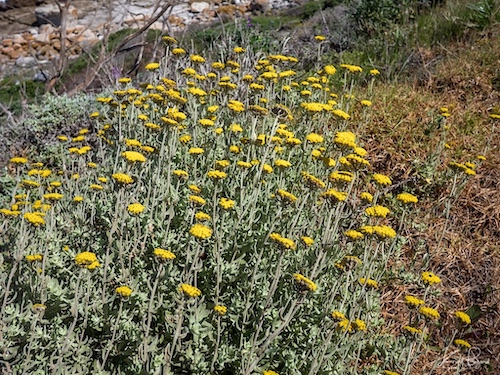
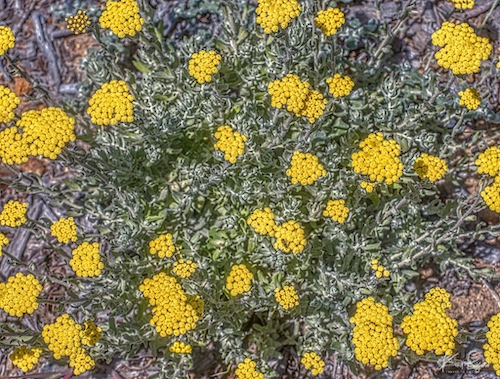
Helichrysum cymosum subsp. cymosum is a very attractive and easy-to-grow groundcover with small silvery grey leaves, covered with masses of bright yellow flowers that flowers between September and April. It has bright canary-yellow flowers in flat-topped flowerheads that look like masses of small discs. Each flowerhead is a cluster of 6–20 flowers. There are two recognized subspecies of Helichrysum cymosum : subsp. cymosum and subsp. calvum which occurs mostly in the Grassland Biome. The two subspecies can be confused but the difference between them is that subsp. calvum has smaller flowerheads with fewer flowers per flowerhead (4–7 flowers) and generally narrower leaves. About 240 species of Helichrysum are indigenous in southern Africa. The genus name Helichrysum, derived from the Greek words helios, which means sun, and chrysos, gold, and refers to the golden flowerheads of many species in this genus. The word cymosum (Latin) means ‘with cymes’, which are flower clusters in which the flowers open from the centre outward, referring to the flat-topped clusters of flowerheads.
Cape Dandelion
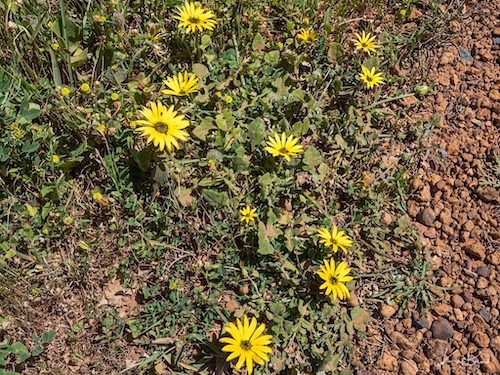
Arctotheca calendula is a plant in the sunflower family commonly known as capeweed, plain treasureflower, cape dandelion, or cape marigold because it originates from the Cape Province in South Africa. It is also found in neighboring KwaZulu-Natal. It is naturalized in California, Spain, Portugal, Italy, Australia, and New Zealand, and considered a noxious weed in some of those places. Arctotheca calendula is a squat perennial or annual which grows in rosettes and sends out stolons (runners) and can spread across the ground quickly. The leaves are covered with white woolly hairs, especially on their undersides. The leaves are lobed or deeply toothed.
African Daisy
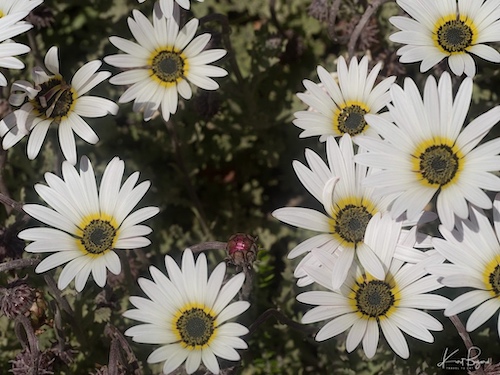
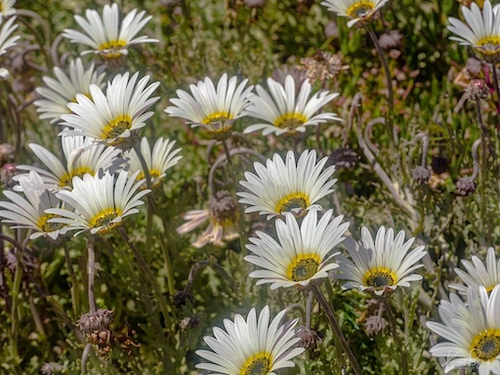
Arctotis stoechadifolia, the African daisy or white arctotis, is a rare species of South African plants in the daisy family. It is a rare plant found only in sand dunes along the west coast of Cape Province. An aggressive low-growing groundcover that hugs the ground with leafy, ribbed stems and toothed large leaves that are grayish-green and covered with many fine white hairs. The stems can root where they are in contact with the ground. The large daisy-like flowers are white with a steel blue center that is encircled by a band of yellow. In California and Southern Australia where Arctotis stoechadifolia is often planted in gardens or as a coastal sand-stabilizing plant, it is starting to become a weed as it invades natural areas. This is a problem, as it smothers and eliminates the indigenous plants through shading and competition of resources, which again result in a loss of biodiversity, as large areas are covered only by Arctotis stoechadifolia.
Rough Arctotis
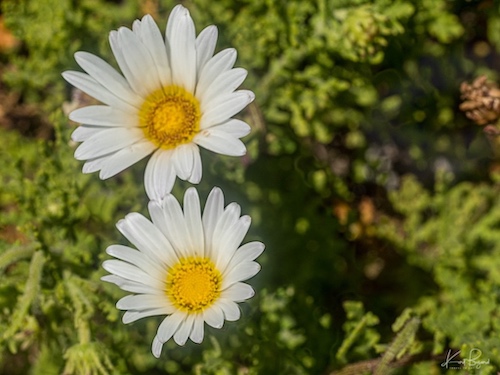
Arctotis aspera, Rough Arctotis or Taaigousblom, is a tough, soft-wooded perennial from the mountainous and coastal fynbos areas that flowers for the most part of the year. Once established, it hardly needs any water. The genus Arctotis was named by Linnaeus and means ’ear of a bear’ from Greek arctos, meaning ‘a bear’, and otis, ‘ear’, and refers to the scales on the pappus (fine hairs on the fruit) with its ear-like appearance. The specific epithet aspera, is from Latin and means ‘rough’ and is in reference to roughly textured hairy stems and leaves. Arctotis consists of roughly 64 species in southern Africa and Angola. In South Africa species are found in the Western and Eastern Cape, Namaqualand-region and extend further east to other parts of the country. No species have been recorded in Swaziland.
Struthiola myrsinites
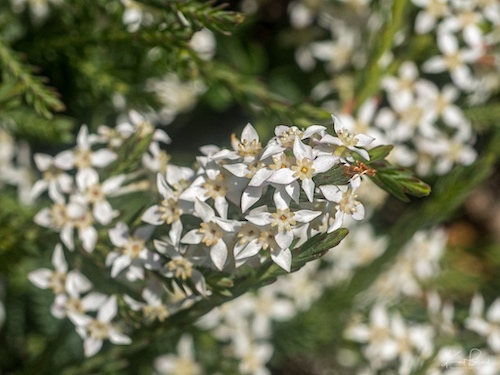
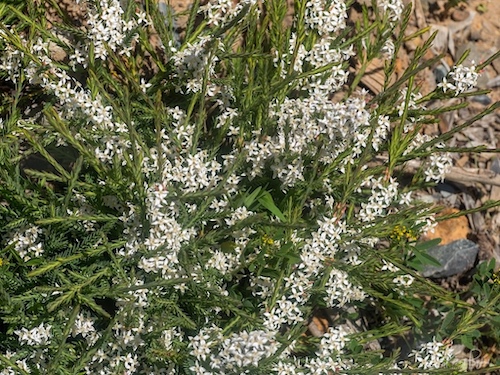
This is a delightful, slender shrub from the Cape flora, whose pale flowers scent the evening air. It is a member of the thyme family which is recognised by bark which tears into long strips. The name Struthiola is derived from the Greek word for a small bird or sparrow and may refer to the tiny seed resembling a sparrow’s beak. The specific name myrsinites refers to its similarity to the genus Myrsine, which name in turn refers to the Greek name for the common myrtle. The flowers have a well-developed calyx with 4 or 5 lobes, often resembling petals. The petals are absent or reduced to scale-like or fleshy lobes at the mouth of the calyx. Struthiola myrsinites occurs widely in sandy soil, often near watercourses. There are about 42 species of Struthiola altogether, found in tropical and southern Africa, with about 20 of these occurring in the Cape Flora.
Struthiola striata
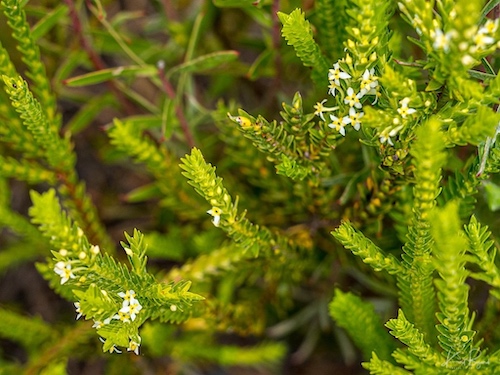
A pretty shrub with four petaloid scales and cream-coloured flowers, honey-scented at night. The number of petaloid scales has been used in the past to distinguish 3 main groups within the genus, namely those with 4, 8 or 12 scales. The 4-scaled group consists of 2 species, S. striata and S. tetralepis. These species are distinguished from each other in that S. striata has ovate sepals and cream-coloured flowers, whereas Struthiola tetralepis from the Hottentots Holland Mts, has lanceolate sepals and greenish yellow flowers that fade to red. The pale flowers with slender floral tube, included anthers, and nocturnal fragrance, are characteristic of moth-pollinated plants.
Silver Everlasting
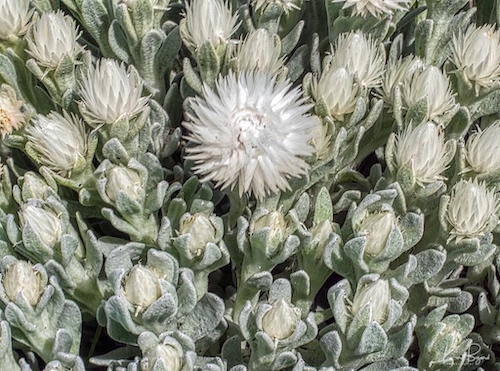
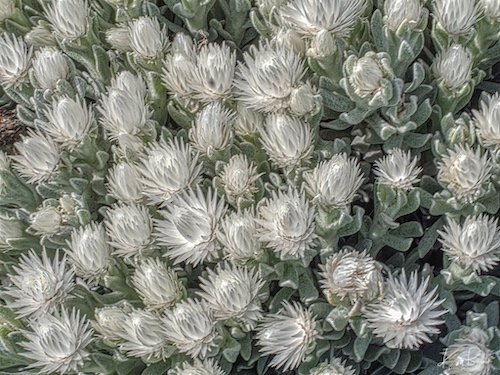
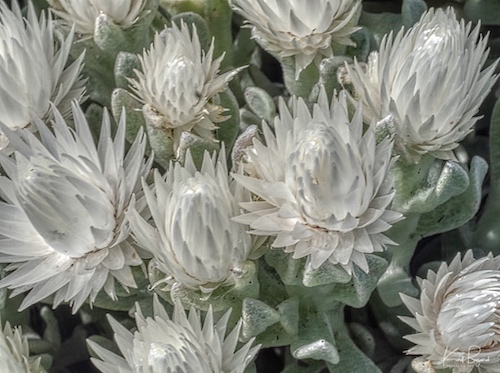
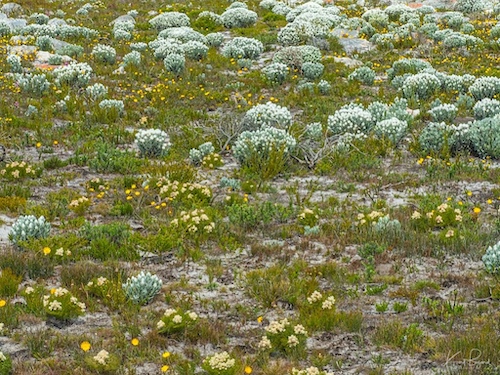
At the height of its flowering, this relatively short-lived, woolly shrublet forms masses of beautiful white flowerheads that shine in the bright light of summer. Growing up to 3 feet (1 m) tall, this compact, much-branched shrublet has soft woody stems and branches and a thick covering of grey-woolly hairs that feels like felt. The densely crowded leaves are erect and narrowly oblong, usually about 5–8mm wide. Towards the branch tips the leaves give way to narrow, dry bracts and finally to a solitary, conical flowerhead about 20 mm wide. The genus Syncarpha is confined to southern Africa and includes about 30 species, the majority of which are endemic to the Greater Cape Floristic Region, an area that encompasses the winter-rainfall and all year-rainfall regions of southern Africa. Only four species extend eastwards into the summer-rainfall region of the Eastern Cape Province. Other showy members of the family are Syncarpha argyropsis and Syncarpha eximia.
Golden Spiderhead
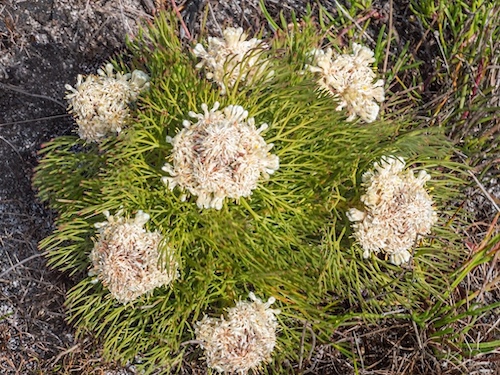
Serruria villosa is an erect shrublet growing about one foot (0.3–0.5 m) tall and spreading to one foot (0.3 m). It has a neat, multi-stemmed habit, and forms a dense little bush. Leaves are needle-like with very fine hairs and curve upwards. They are 1–1/2 inches (20–40 mm) long and have hard black tips. Single golden yellow flower heads are produced on the tips of branches. Each yellow flower is topped with a fluffy white perianth. Flower heads measure 20–25 mm across and consist of up to 25 individual flowers. The golden spiderhead is endemic to the Cape Peninsula, meaning it occurs nowhere else. Serruria was named after Dr James Serrurier who was a professor of botany at Utrecht in the early 18th century. Villosa means hairy and refers to the shaggy white hairs found on the perianth. The Serruria genus contains 55 species. They can be distinguished from other members of the Protea family by their dissected leaves which have cylindrical segments. Serruria villosa is adapted to and requires fire for survival in its fynbos habitat. Plants grow, flower, produce seed and eventually, after 10–15 years, become old and scrappy. At this stage fynbos is ready to burn. Serruria villosa is killed by fire but seed has been collected and safely stored underground by indigenous ants.
Buttonbush
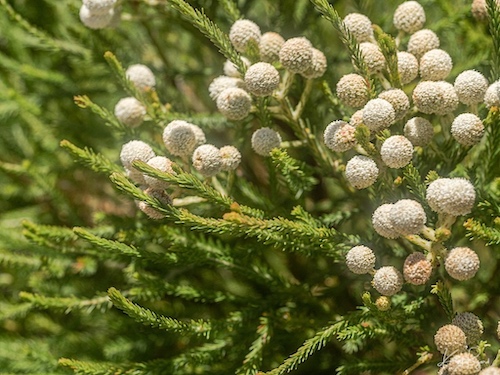
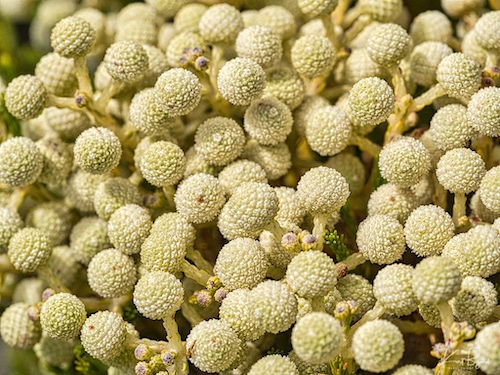
This plant is native to wet sandy flats and seeps along slopes in the Western Cape of South Africa. It is in a plant family, the Bruniaceae, that is endemic to this area with 12 species in the genus. The name Berzelia honors Swedish chemist Jacob J. Berzelius. The specific epithet ‘lanuginosa’ is Latin for “wool” in reference to the fluffy white flower heads. They are compact shrubs with neat foliage, grown for their crowded, rounded heads of creamy flowers produced in late spring to summer.
Broad Leaf Sugarbush
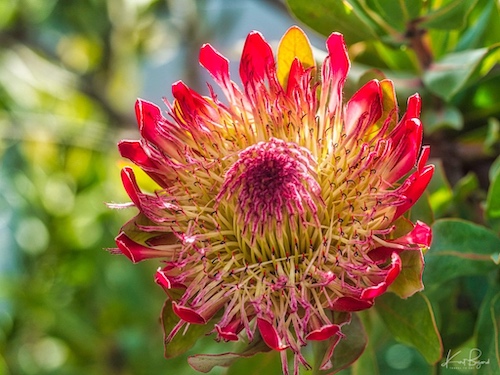
Protea eximia, the broad-leaved sugarbush, is a shrub that may become a small tree, which occurs in mountain fynbos on mainly acidic sandy soils; the species was very well known under its old name of Protea latifolia. The flowers have awns that are covered in purple-black velvety hairs, and are contained within a series of rings of involucral bracts that have the appearance of petals. The fruit is a densely hairy nut, many of which are inserted on a woody base. The flowers are borne terminally on long shoots, and have a tendency to become very untidy as they age. The genus is named after the Greek god Proteus, who was able to change his shape at will, an indication of the diversity and variety to be found in the Protea family. It bears red-pink, open flower heads about 5” across for most of the year. Protea eximia is widespread throughout the mountains of the southern Cape, from the Keeromsberg near Worcester, along the Langeberg, Outeniqua and Tzitzikamma Mountains to Van Stadensberg near Port Elizabeth. It is also found on the Waboomsberg, Klein Swartberg, Rooiberg, Groot Swartberg, Kamanassie and Kouga Mountains and Strydomsberg. Protea eximia was discovered by James Niven in the Swartberg, probably soon after 1805. He sent seed back to Lee and Kennedy’s Nursery in London and the plants flowered in 1809. J.W. Mathews, curator of Kirstenbosch from 1913 until 1936, introduced P. eximia to the garden in 1914 from seed that he collected on the Swartberg Pass.
Red-Edged Pig’s Ear
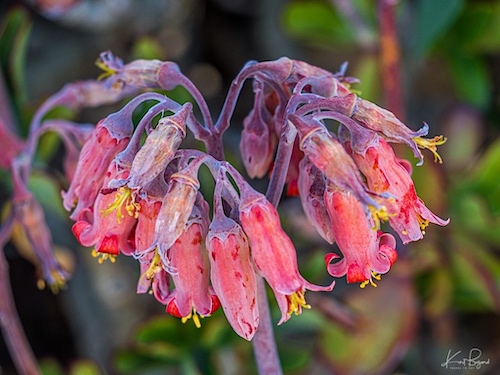

Cotyledon orbiculata, commonly known as pig’s ear or round-leafed navel-wort, is a South African succulent plant belonging to the genus Cotyledon. Cotyledon orbiculata is an extremely variable species that grows to approximately 4.3 feet (1.3 m) in height. It has gray-green leaves that can be up to 5 by 3 inches (13 by 7 cm) with a white powdery substance on them that helps reflect sunlight and conserve water. The shape of the leaves was thought to have a resemblance to a pig’s ear, thus the common name. The bell-shaped flowers are small, usually less than 1.2 inches (3 cm) in length, and droop from the top of a 2 feet (60 cm) tall stalk. The flowers are usually orange-red but yellow varieties also exist. Cotyledon orbiculata has five varieties, based on differences in leaf and flower shape. The variability of leaf size, shape and color is also influenced by the immediate environment. Selected forms in cultivation have been given names such as Elk Horns or Silver Waves.
Hooded-Leaf Pelargonium
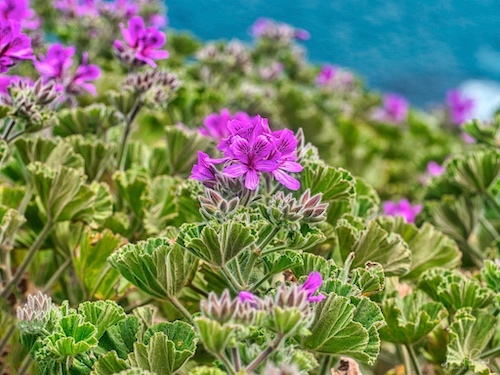
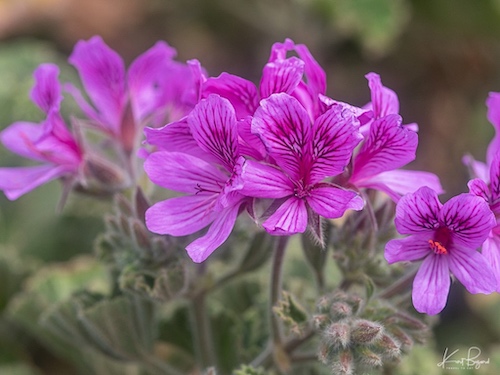
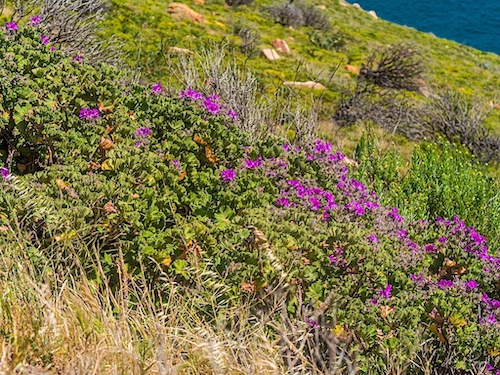
Pelargonium cucullatum is a hairy, upright, branching, perennial shrub, of 1–2 m (3.3–6.6 ft) high, that has been assigned to the cranesbill family. The family includes both the genus Geranium (the cranesbills, or true geraniums) and the garden plants called geraniums, which modern botany classifies as genus Pelargonium, along with other related genera. It sprouts new stems from the underground rootstock and becomes woody at its base. The Hooded-Leaf Pelargonium was first collected for science by Dutch botanist Paul Hermann in 1672, and was probably found on the slopes of Table Mountain. As far as known, William Bentinck, 1st Earl of Portland was the first to grow the species in Europe in 1690. The “father of modern taxonomy”, Carl Linnaeus described the species in the Hortus Kewensis, a book by William Aiton that was published in 1789, based on a specimen collected somewhere in Africa, without precise locality, that was illustrated in the Hortus Cliffortianus. Charles Louis L’Héritier de Brutelle assigned it to his genus Pelargonium, creating the new name Pelargonium cucullatum. Pelargonium cucullatum is the type species of the section Pelargonium, the subgenus Pelargonium, and the genus Pelargonium.
Pelargonium betulinum
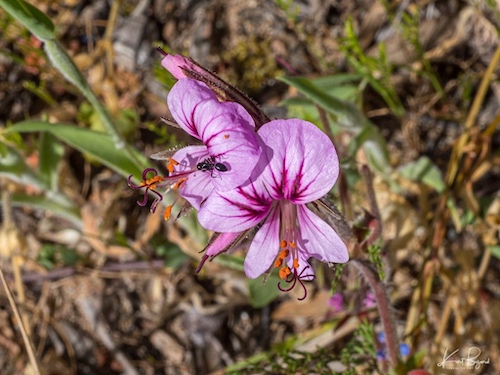
Pelargonium betulium is a hardy, evergreen, rounded, bushy perennial with attractive, aromatic leaves that have purplish-red edges. The common name Kanferblaar is derived from the camphor-like scent of the crushed leaves. This species was probably first cultivated in Holland in around 1738, and was introduced to Britain by Francis Masson in 1786. It is a fast growing, showy, long-flowering but relatively short-lived (5 years) perennial that brings spring color to the mixed border, the shrubbery, fynbos gardens, coastal gardens and beach-front gardens where it looks particularly striking when the white, pink and purple color forms are planted together.
Wildemalva Germanium
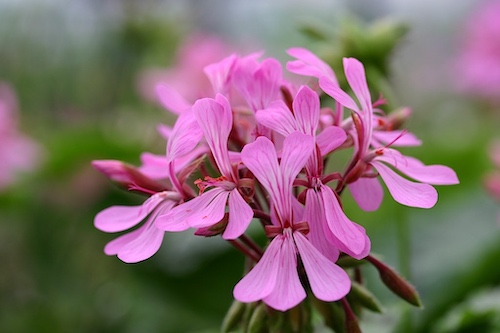
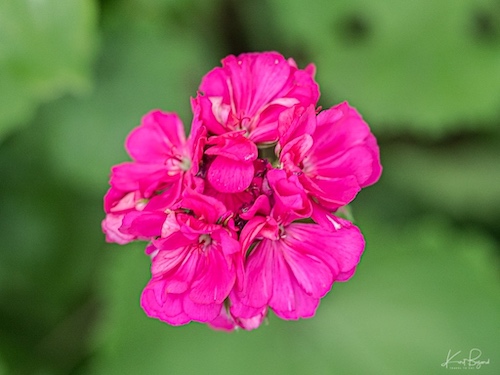

Pelargonium zonale, known as wildemalva in Afrikaans, is a species of Pelargonium native to southern Africa west of the Cape Province, in the geranium family. It is one of the parents of the widely cultivated plant Pelargonium × hortorum, often called “geranium”, “zonal geranium” or “zonal pelargonium”. In the 16th century, Pelargonium seeds were transported from Africa to Leiden in the Netherlands, where the plant was grown in the botanical garden there. Within a few years, it reached the British Isles, France, Italy and Spain and became extremely popular. It gradually reached the islands of the Caribbean, and in the 17th century it was already known in North America. Today it is naturalized in many subtropical and tropical countries and in colder areas must be grown indoors. Hardy geraniums are true, wild geraniums. They are also often referred to as cranesbill geraniums. While the common hardy name might be attributed to their ability to survive in a variety of conditions, the cranesbill moniker comes from the shape of the fruit capsule from which the plant’s seeds are dispensed. Whichever name you prefer, hardy and cranesbill geraniums are one in the same.
Hongerblom
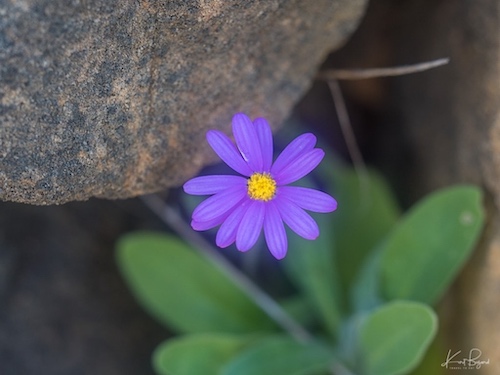
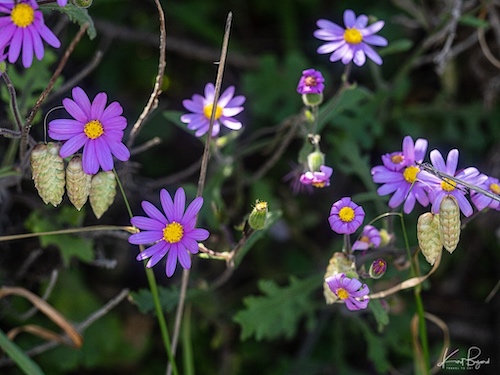
Purple Ragwort or Hongerblom (Senecio arenarius) is native to South Africa, Namibia, and Botswana. This species is found on sandy flats from the southern parts of Namibia and the Northern and Western Cape Provinces of South Africa, towards the Agulhas Plain. In both these provinces it grows both along the coast and further inland amongst, or as part of, seashore vegetation, fynbos (renosterveld and strandveld) and succulent karoo. This species, given its vast geographical distribution, is subjected to various different climatic conditions. In some places the rainfall is about three times as much as others, and in the interior it experiences frost as opposed to none along the coast. Senecio is a genus of the daisy family that includes ragworts and groundsels. The scientific Latin genus name, Senecio, means “old man.” Many genera in Senecio and the whole tribe are in need of revision. Many species currently placed in the genus need to be transferred to other or new genera, and others have been retransferred to Senecio. Some of the popular succulent species that were included within Senecio, such as Curio repens and Curio rowleyanus, are now placed in the Curio genus.
Trailing Ice Plant
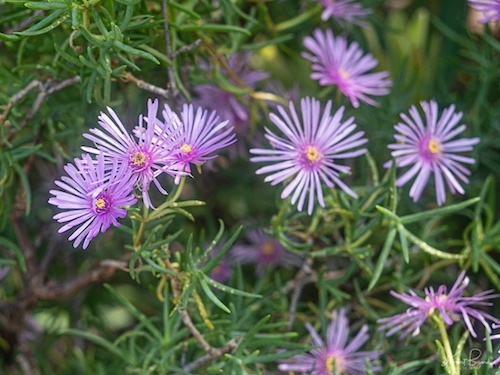
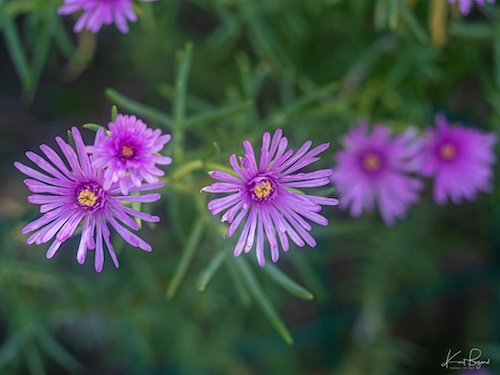
The Aizoaceae Martynov (fig-marigold family) is a large family of dicotyledonous flowering plants containing 135 genera and about 1800 species. They are commonly known as ice plants or carpet weeds. The common name vygie is used for members of the Aizoaceae with showy daisy-like flowers. The name, prounounced “fay-gh-ee”, comes from the Afrikaans for “little fig”. The seedpods do look rather fig-like, especially those belonging to the genus Carpobrotus, which are fleshy and have numerous small seeds inside. Most vygies only open their flowers fully in the sun, when their shiny petals reflect the light in dazzling arrays of whites, pinks and yellows. The best known spring-flowering vygies are the Drosanthemum, Delosperma and Lampranthus species. They include many small shrub-like plants as well as groundcovers, and have an enormous range of flower colors. The genus name “Lampranthus” means “shining-flowers” in Greek, and the species of this genus have unusually large, bright flowers, of a range of colors (sometimes even bi-coloured), that usually appear in summer, and frequently cover the plants entirely. The species of this genus typically have long, smooth, elongated, succulent leaves. These can be triangular or cylindrical, and like all plants in its family, appear in opposite pairs on the shrubs’ branches
West Coast Sour Fig
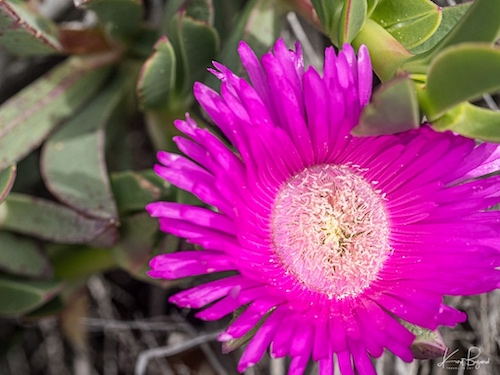
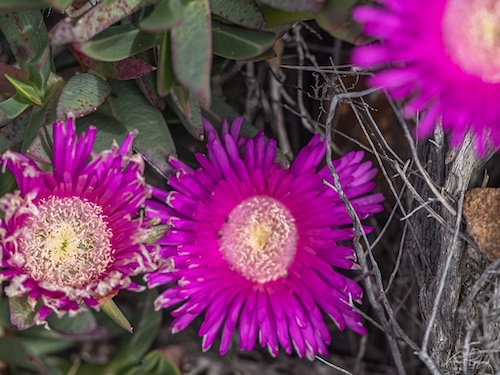
Carpobrotus quadrifidus is a robust succulent perennial with smooth, straight, trailing stems that can easily attain a length of 2.5m. These prostrate stems form dense mat-like matrixes of less than 500mm in height and root readily at nodes where they touch the soil. The leaves are somewhat fused at the base, opposite, straight, 18–25mm in diameter and sharply three-angled (triangular in cross section), with a sharp point. Leaf color varies from shades of green to glaucous (blue-grey). Carpobrotus quadrifidus is found on coastal rocks, sandy duneveld and coastal subtropical thickest on the west coast of South Africa. The species is confined to the western coastal fog-belt in the winter-rainfall area of the Western and Northern Cape. This region is generally flat and characterised by moderate to low rainfall with semi-arid to arid climatic conditions. The entire plant is edible and relished by various animals such as tortoises and mammals such as hare, baboons and several small and large antelope.
Ice Plant
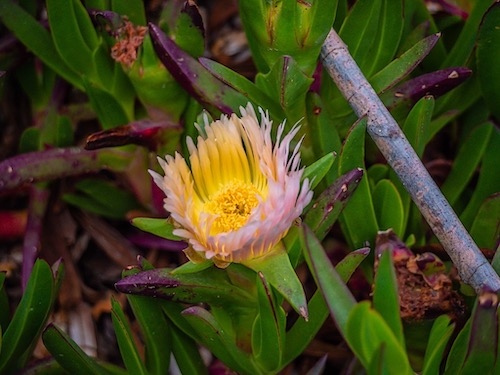
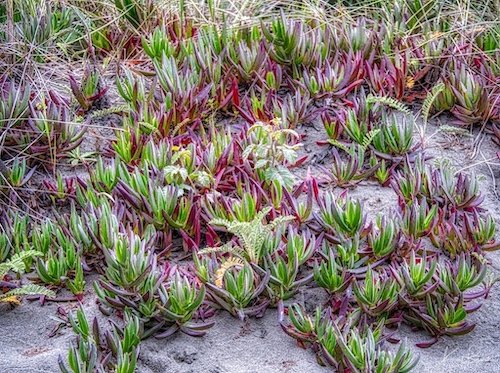
Although the ice plant may have arrived by ship In California as early as the 16th century, it was actively introduced in the early 1900s to stabilize dunes and soil along railroad tracks; it was later put to use by Caltrans for ground cover along freeway embankments. Thousands of acres were planted in California until the 1970s. It easily spreads by seed (hundreds per fruit) and from segmentation (any shoot segment can produce roots). Its succulent foliage, bright magenta or yellow flowers, and resistance to some harsh coastal climatic conditions (salt) have also made it a favored garden plant. Despite its use as a soil stabilizer, it actually exacerbates and speeds up coastal erosion. It holds great masses of water in its leaves, and its roots are very shallow. Carpobrotus edulis has yellow or pink flowers while the slightly smaller Sea Fig (Carpobrotus chilensis) has purple flowers. Both are originally from Southern Africa although they have become invasive species pretty much around the world.
Plectranthus/Coleus
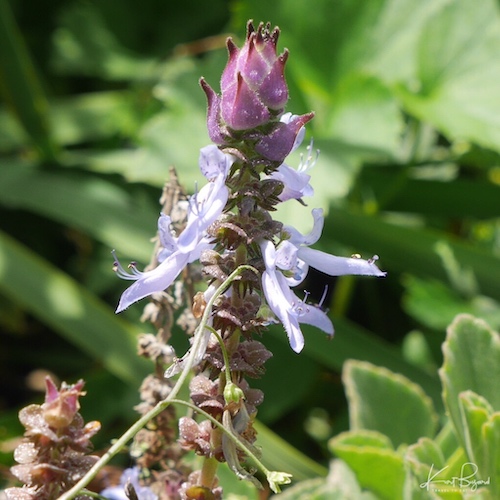
I have loved this unusual Plectranthus Lois Woodhull since the first time I saw it in Albert Park in Auckland. Seeing it again in its home in South Africa brought back a flood of pleasant memories. Coleus is a member of the Lamiaceae or Mint family and smells like camphor. It has been used for over 3,000 years in Ayurvedic Medicine. In ancient Sanskrit texts it is known as Makandi and was said to have been used for supporting healthy functioning heart and lungs, and a number of other functions in the body. Plectranthus is the largest South African genus in the mint family (Lamiaceae), with 44 species natural to the region, most of which occur on the eastern side of the country. Some species are narrowly endemic occurring only in a very limited area, while others are widespread and very variable and consequently difficult to distinguish. As I noted above, Plectranthus are noted for their aromatic leaves when crushed or even brushed against, and the variety of aromas is as diverse as the genus itself. Plectranthus is an unusual plant that was previously in its own genus and now is classified as part of coleus.
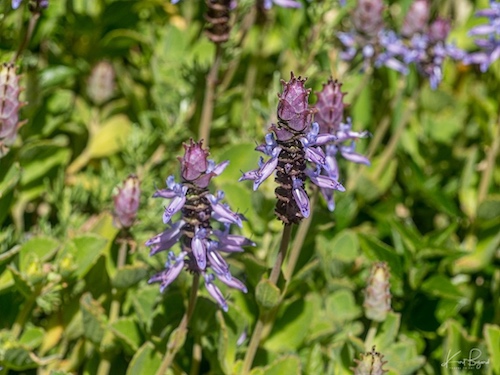
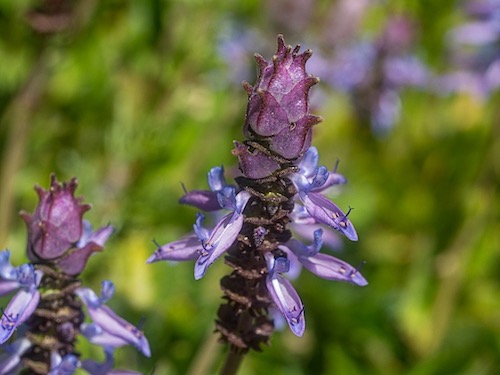
Coleus neochilus is a decumbent to erect, much branched, bushy, aromatic, succulent herb, which grows 8–20 inches (200–500 mm) high and up to 2 feet (600 mm) wide. In some regions, such as in Namibia, it occurs as an annual. The leaves are succulent, grey-green, obovate, finely hairy, often slightly sticky to the touch, margins crenate with 5–6 pairs of teeth. The deep blue and purple flowerheads are borne throughout summer, from spring (September) until autumn (April), with the peak flowering season in autumn. The inflorescence is a terminal spike-like raceme 60–150 mm long. The floral bracts are large, keeled, greenish-cream to purplish with dark purple tips and form a square, 4-angled coma (leaf-like head) at the tip of the inflorescence. These bracts drop soon after the flower opens. Plants can be found growing naturally in dry thickets, usually under trees in the open and sometimes rocky woodland and among rocks in grassland and in bushveld, in the Eastern Cape, KwaZulu-Natal, Mpumalanga, Gauteng, Limpopo and North West provinces in South Africa, as well as in Eswatini, Zimbabwe, Zambia, Namibia and Botswana.
Pride of Madeira
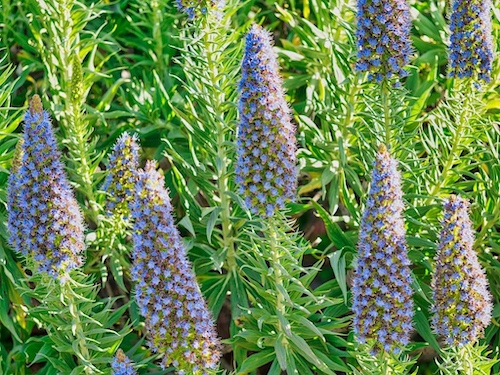
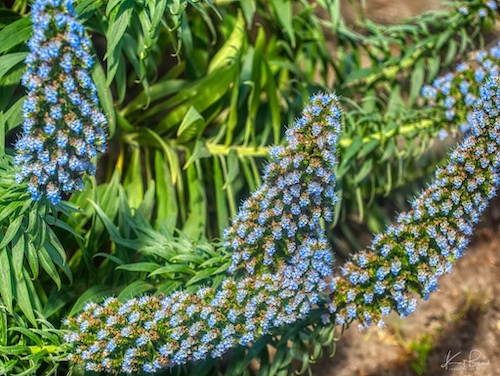
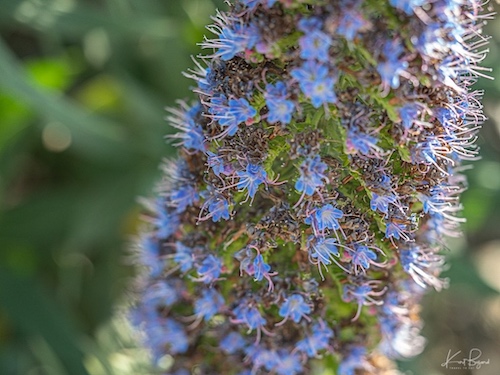
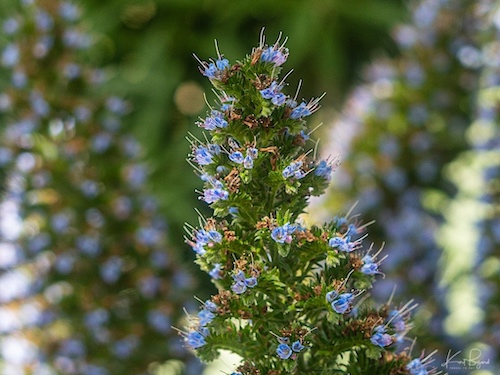
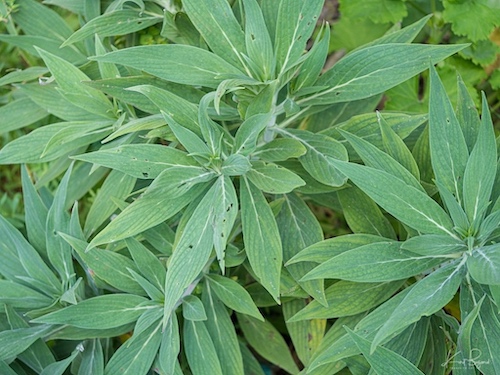
Pride of Madeira is not native to South Africa, but I saw this specimen at Boulders Beach and could not pass up the opportunity to take photographs. Echium candicans, the Pride of Madeira, is a species of flowering plant in the borage family Boraginaceae, native to the island of Madeira in the Canary Islands. It is a large herbaceous perennial subshrub, growing to 5–8 feet (1.5–2.5 m). Echium candicans is cultivated in the horticulture trade and widely available throughout the world as an ornamental plant for traditional and drought tolerant water conserving gardens. It is particularly suitable for coastal planting. With a minimum temperature requirement of 5–7 °C (41–45 °F), in frost-prone areas it needs some winter protection. In California, it is an invasive species. It is removed from native plant communities as part of habitat restoration efforts in coastal parks such as the Golden Gate National Recreation Area.
Invasive Species
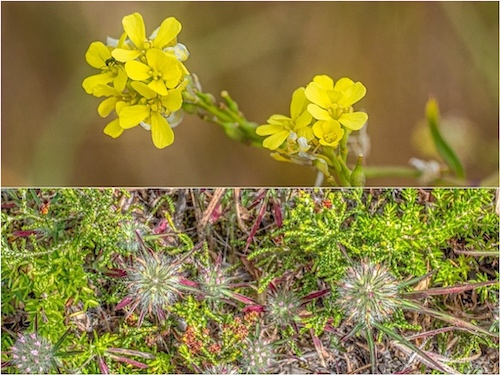
The fynbos is the region of South Africa most affected by invasive alien species which collectively cover around 10% of the entire country. The most common invasive plants are wattles (Acacia species) and hakeas, native to Australia, and pines native to Europe and the Californian coast of the United States. Pines had been introduced to South Africa by the 19th century and the wattles were imported into the mid–1870s to stabilize sand dunes. In South Africa, they take invasive species very seriously, especially at the Cape of Good Hope Nature Reserve but in Table Mountain National Park in general. That said, you cannot eliminate every invasive plant, wild mustard is absolutely everywhere in the world as is Narrowleaf Crimson Clover. As always I hope you enjoyed the posts and will return in the future for more.
[mappress mapid=”253″]
References:
An analysis of the flowering plants and ferns of the Cape of Good Hope Nature Reserve
Introducing The Field Guide for Wild Flower Harvesting
The alien flora of the Cape of Good Hope Nature Reserve. I.A.W. Macdonald, D.L. Clark and H.C. Taylor: S.-Afr. Tydskr. Plantk., 1987, 53(5)
A Vegetation Survey of the Cape Hope Nature Preserve
Plants of southern Africa: an annotated checklist
South Africa’s Proteas: How to Identify Every Type of SA Protea Flower Under the Sun!
Common Buttonbush. Dave’s Garden
Wildflowers Around Arcata California
Silver Everlasting (Syncarpha vestita)
Plectranthus: A Plant for the Future
Nomenclatural changes in Coleus and Plectranthus (Lamiaceae): a tale of more than two genera. 2019
Coleus neochilus (Schltr.) Codd (= Plectranthus neochilus Schltr.)
Kanferblaar (Pelargonium betulinum)
REPORT ON THE SCIENTIFIC RESULTS OF THE VOYAGE OF H.M.S. CHALLENGER

